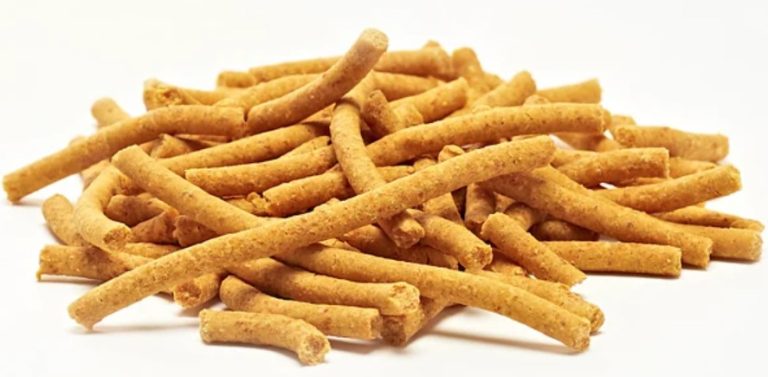Extrudates can be found in many different forms. Examples are oat pops or peanut flips. Here you can find out how they are made and what properties they have.
An extrudate is a food that has been expanded by pressure and high temperatures. This heating and puffing makes it nice and crispy. Starchy foods are usually used to produce extrudates because they are particularly suitable. Examples of this are bran or grinding flour, also known as husks.
How are extrudates formed?

The production of an extrudate is also called extrusion. You can imagine them as follows.
The extruder (the conveying device that applies the pressure) breaks down the starchy raw material through a combination of pressure and high temperatures.
As soon as the raw material comes out of a nozzle, the temperature and pressure drop suddenly, so that water vapor escapes from the dough and air bubbles are trapped in it.
The result is the so-called extrudate. Sometimes the manufacturers roast or dry it afterwards.
The extrudate can then be cut into any desired pieces or post-treated in some other way. For example, it is fried, sweetened or flavored.
The production of extrudates is quite an involved process. You could theoretically make extrudates yourself, but you would need an extruder for that. The extruder is quite expensive and the raw materials required are usually not commercially available. That’s why we would advise against making your own extrudates at home.
This is how you find extrudates in stores – and that’s how healthy they are
You can find extrudates commercially in many different shapes. Some examples:
Cereals (e.g. oat pops)
Snacks (e.g. peanut chips, onion rings or cheese balls)
break bar
Confectionery (e.g. Nippon or Kinder Country)
crispbreads
But how healthy are the different extrudates now?
In general, you should know that the raw materials for making extrudates are mostly industrial waste products. This is the case, for example, with bran or grinding flour.
During the manufacture of the extrudates, the starch is then completely broken down from the raw materials. This process makes the extrudates easy to digest, but it also destroys important amino acids. In addition, the raw materials are highly heated, which leads to a loss of nutritional value. Vitamins contained in grain products are also lost by 50 to 80 percent during extrusion. Because of this, breakfast cereals, for example, are subsequently enriched with vitamins.
All in all, unfortunately, extrudates are often expensive finished products made from cheap raw materials and air. So if you include them in your diet, it is best to combine them with fresh fruit or vegetables.
In addition to the above examples of rather unhealthy extrudates, there are also some healthier extrudates that you can eat with a clearer conscience. These include pasta, which is one of our staple foods. In addition, textured soy, which you can find in the form of soy strips, for example, is also an extrudate. While these products are a bit more recommendable than peanut chips and other snacks, they’re still best enjoyed in moderation.
Durability of extrudates

The extrusion process removes certain enzymes from the products, making them more perishable. In addition, the extrudates hardly contain any moisture since they are dried foods. These two facts make extrudates last a long time. As a rule, they can be kept for at least a year, usually even longer. So you can keep them for a very long time without worrying about them spoiling or expiring.

